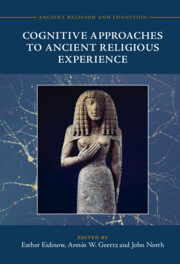Book contents
- Cognitive Approaches to Ancient Religious Experience
- Ancient Religion and Cognition
- Cognitive Approaches to Ancient Religious Experience
- Copyright page
- Contents
- Figures and Tables
- Contributors
- Abbreviations
- Funder Acknowledgement
- Introduction
- Part I Ritual
- Part II Representation
- Part III Gender
- Part IV Materiality
- Chapter 8 Walls and the Ancient Greek Ritual Experience
- Chapter 9 Identifying Symptoms of Religious Experience from Ancient Material Culture
- Part V Texts
- Index
- References
Chapter 8 - Walls and the Ancient Greek Ritual Experience
The Sanctuary of Demeter and Kore at Eleusis
from Part IV - Materiality
Published online by Cambridge University Press: 28 July 2022
- Cognitive Approaches to Ancient Religious Experience
- Ancient Religion and Cognition
- Cognitive Approaches to Ancient Religious Experience
- Copyright page
- Contents
- Figures and Tables
- Contributors
- Abbreviations
- Funder Acknowledgement
- Introduction
- Part I Ritual
- Part II Representation
- Part III Gender
- Part IV Materiality
- Chapter 8 Walls and the Ancient Greek Ritual Experience
- Chapter 9 Identifying Symptoms of Religious Experience from Ancient Material Culture
- Part V Texts
- Index
- References
Summary
The shape and form of boundary walls around and within Greek sanctuaries, and the impact those boundaries had on the experience of the ritual happening within, have attracted little scholarly attention, especially in comparison to work on the powerful impacts of other elements of sanctuary architecture, and architecture more widely. This article, using the case study of the high temenos walls and those of the Telesterion temple structure of the sanctuary of Demeter and Kore at Eleusis, explores the active impact these walls had on particularly the sight- and sound-scapes engaged with by participants. As such it argues for the crucial importance of these walls at Eleusis in creating the intensity, emotion, power, and conviction of the ritual experience of the Mysteries for participants.
- Type
- Chapter
- Information
- Cognitive Approaches to Ancient Religious Experience , pp. 193 - 217Publisher: Cambridge University PressPrint publication year: 2022
References
- 3
- Cited by



